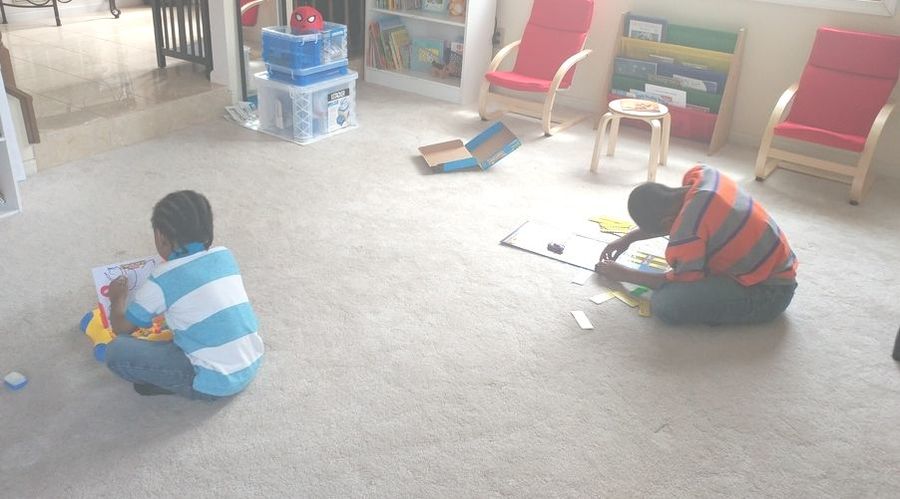|
I'm a huge fan of whole child education and learning through creativity. PFES Academy is fortunate to have 2 very talented friends that visit our classroom to provide music and art education.
Our music class began on July 10th. It is held every other Monday from about 2:15 PM to 2:45 PM. Full-time academy students attend at no extra charge. Part-time students attend at an affordable rate of $30 per month. This week, the students worked on self-regulation, call and response, rhythm, and patterns using Boom Chicka Boom. Our music teacher, Daysha Clark, is an artist at heart. Her day job is visual art (photography, graphics, etc...) but she lends her musical gifts to PFES Academy. Our twice monthly art classes will begin in September, based on enrollment. Full-time academy students pay a reduced rate of $25 per month. Part-time students participate at an affordable rate of $40 per month. Our art teacher, Jill Eulo, has a background in child development and uses art as a medium for personal growth, recreation, and aesthetic joy.  The One-Room Schoolhouse It's been a while since the last post. Our family moved the day before and it's been a whirlwind couple weeks as the students have adjusted to a new norm. One of the most common questions that I'm asked is, "How can you teach different ages and grades?" The answer is, "We figure out what works." It starts with a belief that educating a mixed age and ability group is possible. Historically, students attended a one-room schoolhouse (find reference for history). In the present day, public school teacher are often teaching to a range of 1-3 grade levels in one classroom. Many classrooms are inclusive, and while peers may be approximately the same age, there are often mixed ability levels. As a former public school educator and tutor, I know firsthand that students are often working on many different levels. Homeschooling co-ops, homeschooling families, charter schools, and other alternative education programs have all demonstrated success in teaching multi-age groups. What's Working? There are always some road bumps as students get acclimated to a new environment. So far, what is really working well for us at the Academy is: 1) Consistent routine - We have a monthly theme, a weekly theme, and a daily curriculum integration. We do 3 activities per block and we use music to transition. This accomplishes a few things. The kids know what to expect and so they feel safe. They are familiar with the songs and some of the materials. This allows them to easily participate. It also gives us a common language to describe our day. Soon, the students will have visual schedules to refer to. 2) Simple, enforceable rules - Child development experts across the board recommend using about 3-5 rules to maintain order and structure. A rule that cannot be enforced, is no rule at all. The majority of our rules involve maintain personal space and safety. Things like, keep your hands to yourself and stay in your space in your area. We have flexible seating so there's a lot of movement leeway in one's personal space. For teaching, I ask that students have a listening face in a listening space. And I explain what that looks like. 3) Working in spurts - Our blocks are typically broken down into a 10-15 minute teacher led activity, a interactive group activity, and an independent activity. Using music and movement for transitions can help keep the students calm and focused. As more students enroll, the dynamics will shift and we will find new things that work. As the students mature and regress, we will find new things that work. As I learn and grow, we will find new things that work.
We are a participant in the Amazon Services LLC Associates Program, an affiliate advertising program designed to provide a means for us to earn fees by linking to Amazon.com and affiliated sites. This program is one way to support our organization at no additional cost to you.

Change is Hard! I meant to post yesterday but I was exhausted! Provision FES Academy opened July 5th, 2017 with 2 academy students. Having been out of the teaching game for, oh... 11 years, we had a slightly bumpy ride. Our first students have been homeschooled but have not been used to a daily structure. That's quite a transition for younger students. Especially a newly 5 year old. It's also a transition for our family. One of my favorite things of being a relaxed homeschool family is rolling out of bed whenever we like. PFES Academy means we get up EARLY. It's totally worth it though. At the end of the day, both of our students said they had fun. And they learned a lot! Day 1 Highlights Mixed age is always a bit tricky. Teachers (Special Education, General Education, and Homeschool) have to get used to teaching to different abilities, especially at the elementary level. My method is to start with the basics and differentiate up. I used a deck of Alphabet Cards and had my non-reader identify letters, and my reader tell me the word. I used this as an informal assessment. They got tired after a few letters but I got a lot of information. I used a 100 chart for math. I learned my |
AuthorShay Malone is a development specialist. A certified teacher (emotional and learning disabilities and middle school mathematics) with a background in psychology, she has worked with children and families for over 15 years in many different capacities. She believes that emotional growth is just as important as academic achievement. Shay is an advocate for homeschooling, exceptional learners and quality education. Archives
September 2018
Categories
All
|
Telephone757-209-2095
|
|

 RSS Feed
RSS Feed
